Evaluating Organizational Structure, Culture, and Performance at M&S
VerifiedAdded on 2023/06/18
|10
|2545
|250
Report
AI Summary
This report examines the influence of organizational structure and culture on the performance of Marks and Spencer (M&S), a leading UK-based multinational retailer. It highlights the significance of a strong organizational framework and culture in enhancing organizational performance. The report discusses various organizational structures, including functional, divisional, matrix, and flat structures, noting that M&S follows a flat structure to promote open communication and employee involvement in decision-making. It also explores Charles Handy's model of organizational culture, contrasting M&S's past power culture with its current role culture, which emphasizes innovation and customer service. Furthermore, the report delves into the behavioral approach to management, focusing on how individual behavior, influenced by personal, psychological, organizational, and environmental factors, impacts workplace dynamics and overall performance. The analysis concludes that organizational structure and culture, along with behavioral management, are critical for M&S's success and sustained performance.
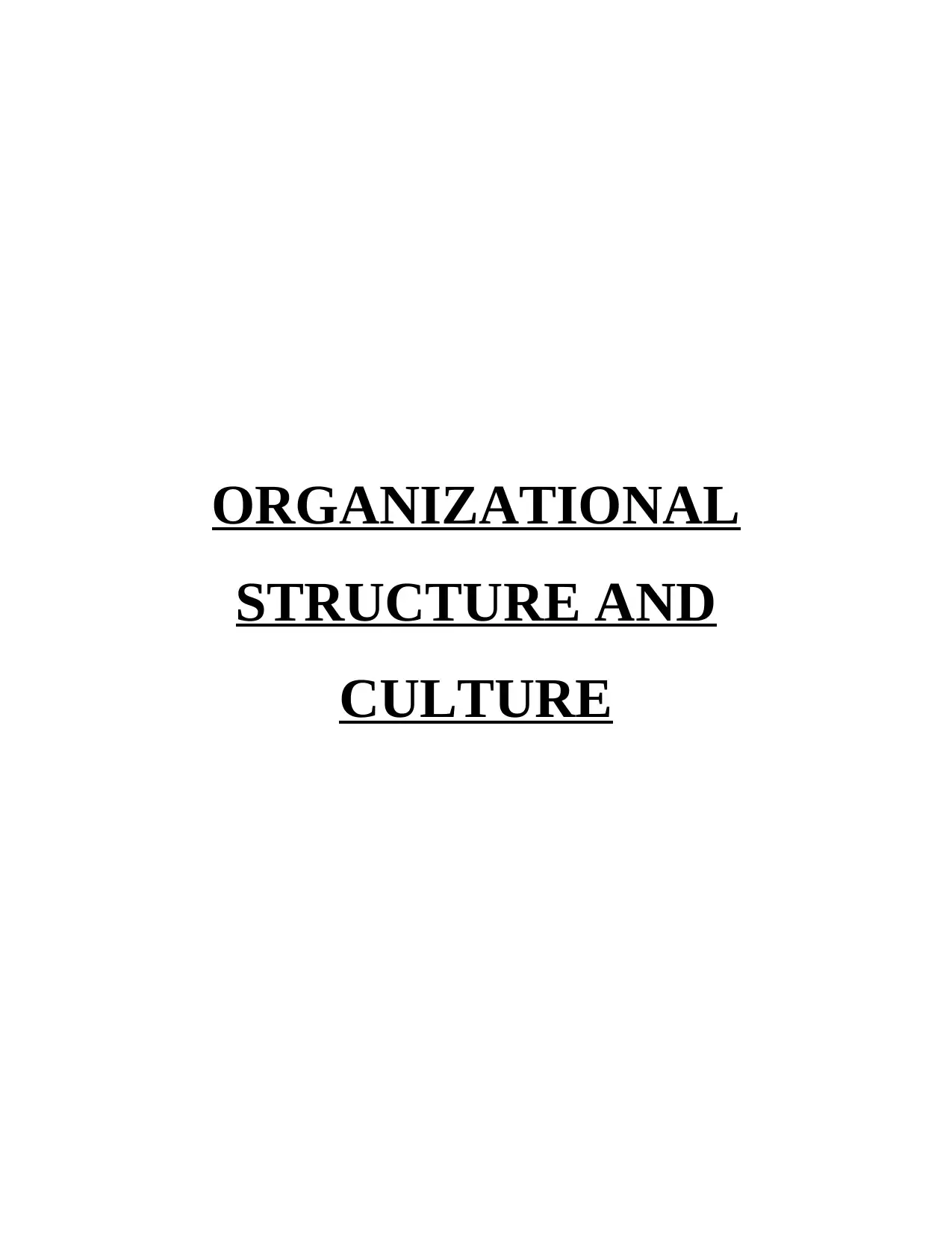
ORGANIZATIONAL
STRUCTURE AND
CULTURE
STRUCTURE AND
CULTURE
Paraphrase This Document
Need a fresh take? Get an instant paraphrase of this document with our AI Paraphraser
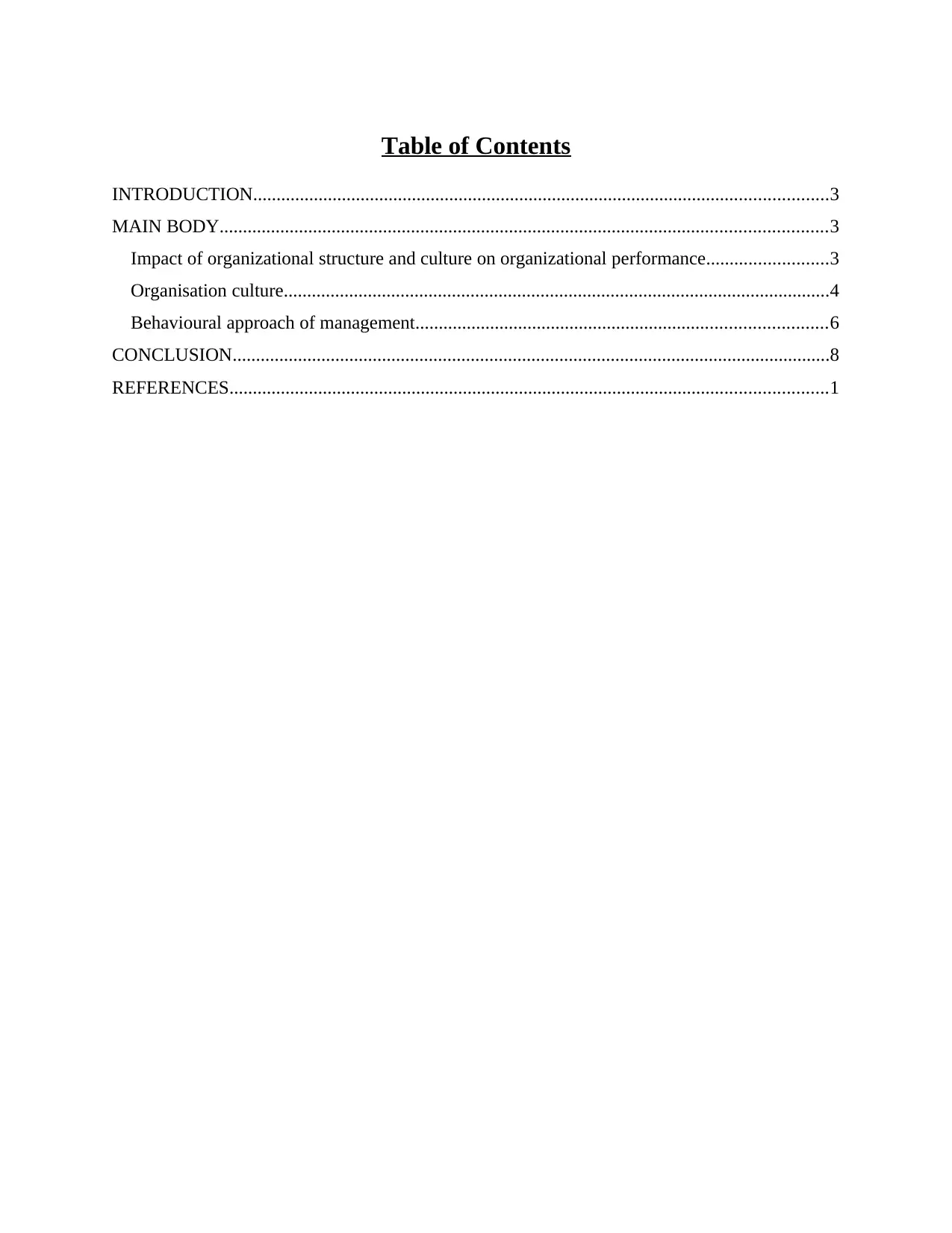
Table of Contents
INTRODUCTION...........................................................................................................................3
MAIN BODY..................................................................................................................................3
Impact of organizational structure and culture on organizational performance..........................3
Organisation culture.....................................................................................................................4
Behavioural approach of management........................................................................................6
CONCLUSION................................................................................................................................8
REFERENCES................................................................................................................................1
INTRODUCTION...........................................................................................................................3
MAIN BODY..................................................................................................................................3
Impact of organizational structure and culture on organizational performance..........................3
Organisation culture.....................................................................................................................4
Behavioural approach of management........................................................................................6
CONCLUSION................................................................................................................................8
REFERENCES................................................................................................................................1
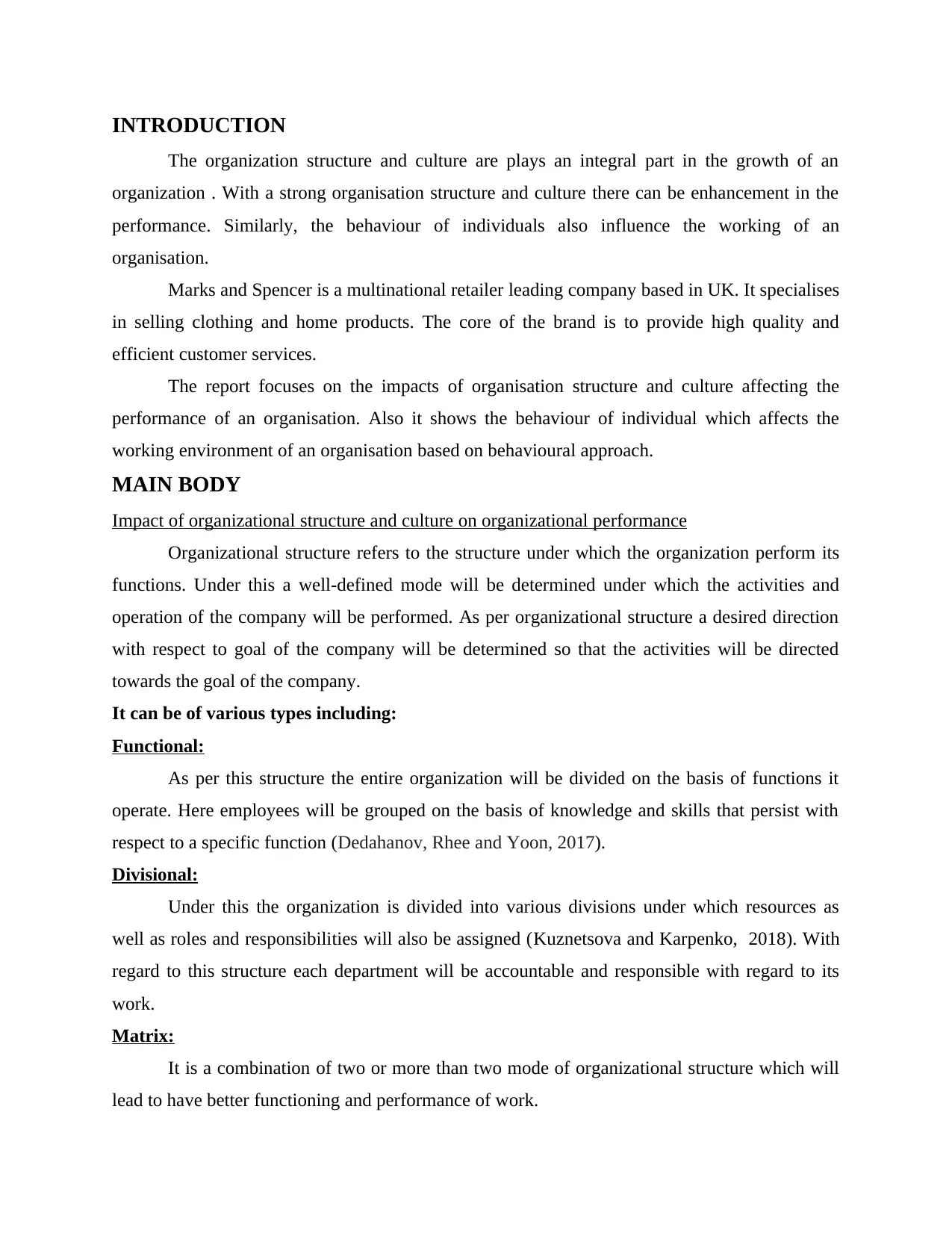
INTRODUCTION
The organization structure and culture are plays an integral part in the growth of an
organization . With a strong organisation structure and culture there can be enhancement in the
performance. Similarly, the behaviour of individuals also influence the working of an
organisation.
Marks and Spencer is a multinational retailer leading company based in UK. It specialises
in selling clothing and home products. The core of the brand is to provide high quality and
efficient customer services.
The report focuses on the impacts of organisation structure and culture affecting the
performance of an organisation. Also it shows the behaviour of individual which affects the
working environment of an organisation based on behavioural approach.
MAIN BODY
Impact of organizational structure and culture on organizational performance
Organizational structure refers to the structure under which the organization perform its
functions. Under this a well-defined mode will be determined under which the activities and
operation of the company will be performed. As per organizational structure a desired direction
with respect to goal of the company will be determined so that the activities will be directed
towards the goal of the company.
It can be of various types including:
Functional:
As per this structure the entire organization will be divided on the basis of functions it
operate. Here employees will be grouped on the basis of knowledge and skills that persist with
respect to a specific function (Dedahanov, Rhee and Yoon, 2017).
Divisional:
Under this the organization is divided into various divisions under which resources as
well as roles and responsibilities will also be assigned (Kuznetsova and Karpenko, 2018). With
regard to this structure each department will be accountable and responsible with regard to its
work.
Matrix:
It is a combination of two or more than two mode of organizational structure which will
lead to have better functioning and performance of work.
The organization structure and culture are plays an integral part in the growth of an
organization . With a strong organisation structure and culture there can be enhancement in the
performance. Similarly, the behaviour of individuals also influence the working of an
organisation.
Marks and Spencer is a multinational retailer leading company based in UK. It specialises
in selling clothing and home products. The core of the brand is to provide high quality and
efficient customer services.
The report focuses on the impacts of organisation structure and culture affecting the
performance of an organisation. Also it shows the behaviour of individual which affects the
working environment of an organisation based on behavioural approach.
MAIN BODY
Impact of organizational structure and culture on organizational performance
Organizational structure refers to the structure under which the organization perform its
functions. Under this a well-defined mode will be determined under which the activities and
operation of the company will be performed. As per organizational structure a desired direction
with respect to goal of the company will be determined so that the activities will be directed
towards the goal of the company.
It can be of various types including:
Functional:
As per this structure the entire organization will be divided on the basis of functions it
operate. Here employees will be grouped on the basis of knowledge and skills that persist with
respect to a specific function (Dedahanov, Rhee and Yoon, 2017).
Divisional:
Under this the organization is divided into various divisions under which resources as
well as roles and responsibilities will also be assigned (Kuznetsova and Karpenko, 2018). With
regard to this structure each department will be accountable and responsible with regard to its
work.
Matrix:
It is a combination of two or more than two mode of organizational structure which will
lead to have better functioning and performance of work.
⊘ This is a preview!⊘
Do you want full access?
Subscribe today to unlock all pages.

Trusted by 1+ million students worldwide
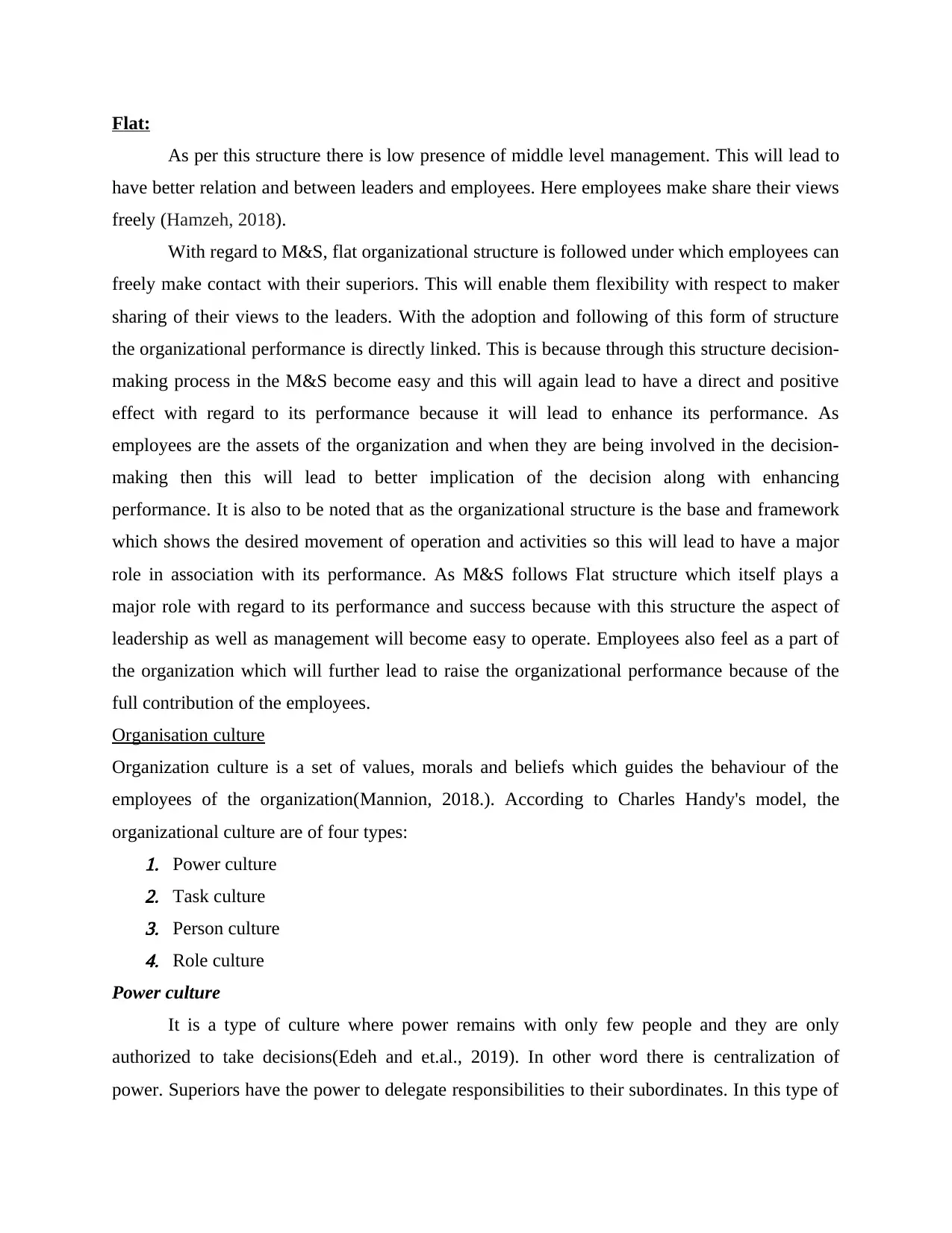
Flat:
As per this structure there is low presence of middle level management. This will lead to
have better relation and between leaders and employees. Here employees make share their views
freely (Hamzeh, 2018).
With regard to M&S, flat organizational structure is followed under which employees can
freely make contact with their superiors. This will enable them flexibility with respect to maker
sharing of their views to the leaders. With the adoption and following of this form of structure
the organizational performance is directly linked. This is because through this structure decision-
making process in the M&S become easy and this will again lead to have a direct and positive
effect with regard to its performance because it will lead to enhance its performance. As
employees are the assets of the organization and when they are being involved in the decision-
making then this will lead to better implication of the decision along with enhancing
performance. It is also to be noted that as the organizational structure is the base and framework
which shows the desired movement of operation and activities so this will lead to have a major
role in association with its performance. As M&S follows Flat structure which itself plays a
major role with regard to its performance and success because with this structure the aspect of
leadership as well as management will become easy to operate. Employees also feel as a part of
the organization which will further lead to raise the organizational performance because of the
full contribution of the employees.
Organisation culture
Organization culture is a set of values, morals and beliefs which guides the behaviour of the
employees of the organization(Mannion, 2018.). According to Charles Handy's model, the
organizational culture are of four types:1. Power culture2. Task culture3. Person culture4. Role culture
Power culture
It is a type of culture where power remains with only few people and they are only
authorized to take decisions(Edeh and et.al., 2019). In other word there is centralization of
power. Superiors have the power to delegate responsibilities to their subordinates. In this type of
As per this structure there is low presence of middle level management. This will lead to
have better relation and between leaders and employees. Here employees make share their views
freely (Hamzeh, 2018).
With regard to M&S, flat organizational structure is followed under which employees can
freely make contact with their superiors. This will enable them flexibility with respect to maker
sharing of their views to the leaders. With the adoption and following of this form of structure
the organizational performance is directly linked. This is because through this structure decision-
making process in the M&S become easy and this will again lead to have a direct and positive
effect with regard to its performance because it will lead to enhance its performance. As
employees are the assets of the organization and when they are being involved in the decision-
making then this will lead to better implication of the decision along with enhancing
performance. It is also to be noted that as the organizational structure is the base and framework
which shows the desired movement of operation and activities so this will lead to have a major
role in association with its performance. As M&S follows Flat structure which itself plays a
major role with regard to its performance and success because with this structure the aspect of
leadership as well as management will become easy to operate. Employees also feel as a part of
the organization which will further lead to raise the organizational performance because of the
full contribution of the employees.
Organisation culture
Organization culture is a set of values, morals and beliefs which guides the behaviour of the
employees of the organization(Mannion, 2018.). According to Charles Handy's model, the
organizational culture are of four types:1. Power culture2. Task culture3. Person culture4. Role culture
Power culture
It is a type of culture where power remains with only few people and they are only
authorized to take decisions(Edeh and et.al., 2019). In other word there is centralization of
power. Superiors have the power to delegate responsibilities to their subordinates. In this type of
Paraphrase This Document
Need a fresh take? Get an instant paraphrase of this document with our AI Paraphraser
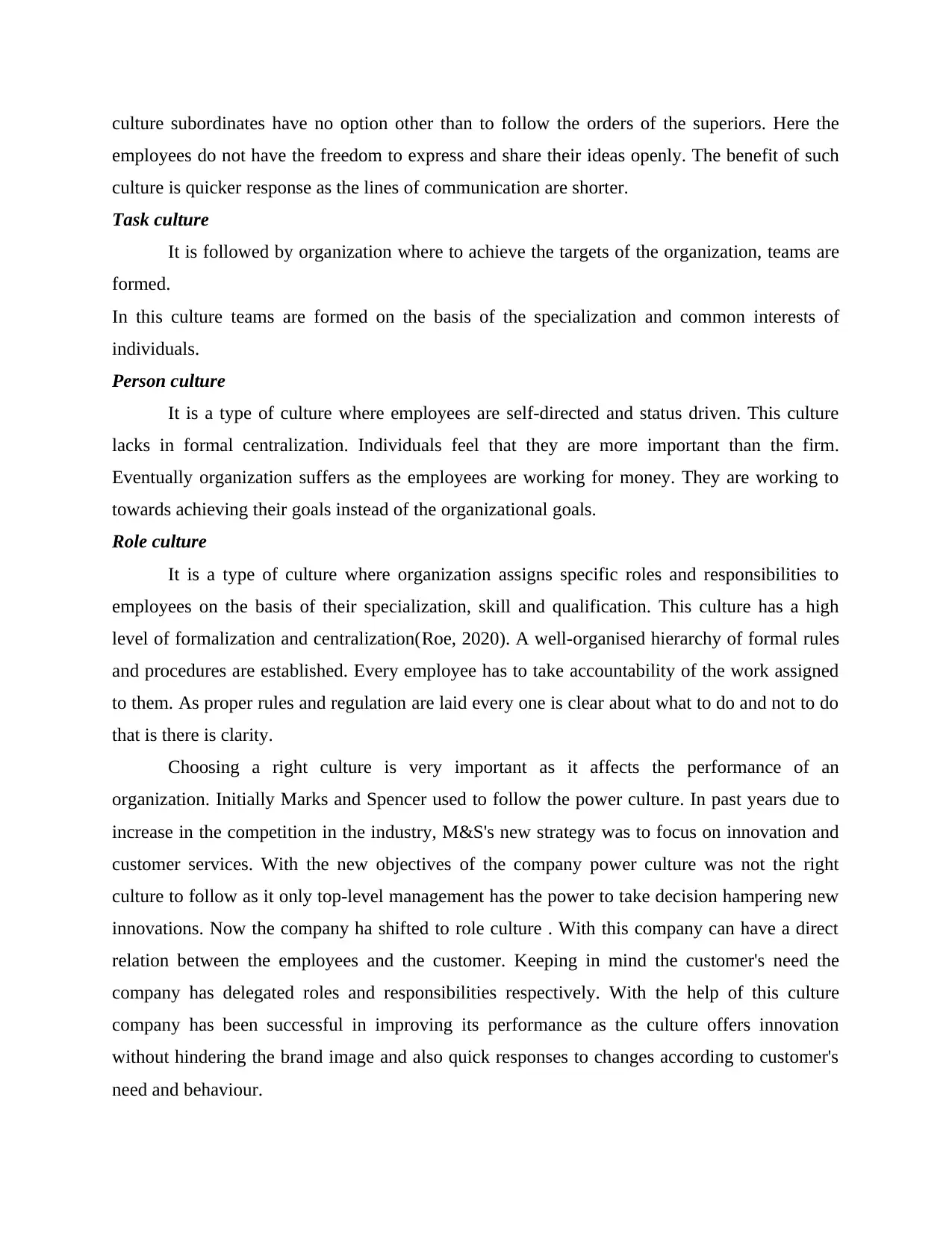
culture subordinates have no option other than to follow the orders of the superiors. Here the
employees do not have the freedom to express and share their ideas openly. The benefit of such
culture is quicker response as the lines of communication are shorter.
Task culture
It is followed by organization where to achieve the targets of the organization, teams are
formed.
In this culture teams are formed on the basis of the specialization and common interests of
individuals.
Person culture
It is a type of culture where employees are self-directed and status driven. This culture
lacks in formal centralization. Individuals feel that they are more important than the firm.
Eventually organization suffers as the employees are working for money. They are working to
towards achieving their goals instead of the organizational goals.
Role culture
It is a type of culture where organization assigns specific roles and responsibilities to
employees on the basis of their specialization, skill and qualification. This culture has a high
level of formalization and centralization(Roe, 2020). A well-organised hierarchy of formal rules
and procedures are established. Every employee has to take accountability of the work assigned
to them. As proper rules and regulation are laid every one is clear about what to do and not to do
that is there is clarity.
Choosing a right culture is very important as it affects the performance of an
organization. Initially Marks and Spencer used to follow the power culture. In past years due to
increase in the competition in the industry, M&S's new strategy was to focus on innovation and
customer services. With the new objectives of the company power culture was not the right
culture to follow as it only top-level management has the power to take decision hampering new
innovations. Now the company ha shifted to role culture . With this company can have a direct
relation between the employees and the customer. Keeping in mind the customer's need the
company has delegated roles and responsibilities respectively. With the help of this culture
company has been successful in improving its performance as the culture offers innovation
without hindering the brand image and also quick responses to changes according to customer's
need and behaviour.
employees do not have the freedom to express and share their ideas openly. The benefit of such
culture is quicker response as the lines of communication are shorter.
Task culture
It is followed by organization where to achieve the targets of the organization, teams are
formed.
In this culture teams are formed on the basis of the specialization and common interests of
individuals.
Person culture
It is a type of culture where employees are self-directed and status driven. This culture
lacks in formal centralization. Individuals feel that they are more important than the firm.
Eventually organization suffers as the employees are working for money. They are working to
towards achieving their goals instead of the organizational goals.
Role culture
It is a type of culture where organization assigns specific roles and responsibilities to
employees on the basis of their specialization, skill and qualification. This culture has a high
level of formalization and centralization(Roe, 2020). A well-organised hierarchy of formal rules
and procedures are established. Every employee has to take accountability of the work assigned
to them. As proper rules and regulation are laid every one is clear about what to do and not to do
that is there is clarity.
Choosing a right culture is very important as it affects the performance of an
organization. Initially Marks and Spencer used to follow the power culture. In past years due to
increase in the competition in the industry, M&S's new strategy was to focus on innovation and
customer services. With the new objectives of the company power culture was not the right
culture to follow as it only top-level management has the power to take decision hampering new
innovations. Now the company ha shifted to role culture . With this company can have a direct
relation between the employees and the customer. Keeping in mind the customer's need the
company has delegated roles and responsibilities respectively. With the help of this culture
company has been successful in improving its performance as the culture offers innovation
without hindering the brand image and also quick responses to changes according to customer's
need and behaviour.
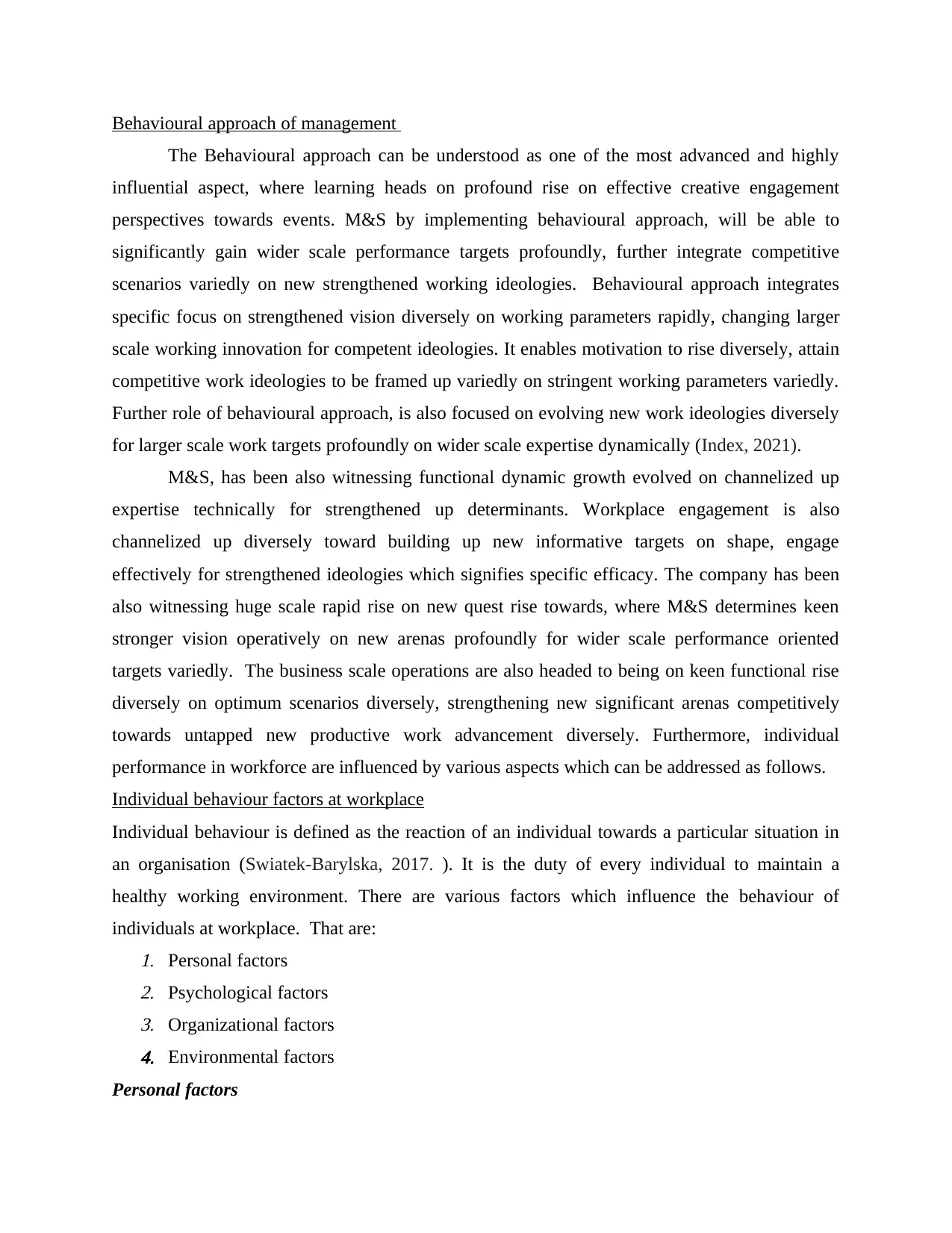
Behavioural approach of management
The Behavioural approach can be understood as one of the most advanced and highly
influential aspect, where learning heads on profound rise on effective creative engagement
perspectives towards events. M&S by implementing behavioural approach, will be able to
significantly gain wider scale performance targets profoundly, further integrate competitive
scenarios variedly on new strengthened working ideologies. Behavioural approach integrates
specific focus on strengthened vision diversely on working parameters rapidly, changing larger
scale working innovation for competent ideologies. It enables motivation to rise diversely, attain
competitive work ideologies to be framed up variedly on stringent working parameters variedly.
Further role of behavioural approach, is also focused on evolving new work ideologies diversely
for larger scale work targets profoundly on wider scale expertise dynamically (Index, 2021).
M&S, has been also witnessing functional dynamic growth evolved on channelized up
expertise technically for strengthened up determinants. Workplace engagement is also
channelized up diversely toward building up new informative targets on shape, engage
effectively for strengthened ideologies which signifies specific efficacy. The company has been
also witnessing huge scale rapid rise on new quest rise towards, where M&S determines keen
stronger vision operatively on new arenas profoundly for wider scale performance oriented
targets variedly. The business scale operations are also headed to being on keen functional rise
diversely on optimum scenarios diversely, strengthening new significant arenas competitively
towards untapped new productive work advancement diversely. Furthermore, individual
performance in workforce are influenced by various aspects which can be addressed as follows.
Individual behaviour factors at workplace
Individual behaviour is defined as the reaction of an individual towards a particular situation in
an organisation (Swiatek-Barylska, 2017. ). It is the duty of every individual to maintain a
healthy working environment. There are various factors which influence the behaviour of
individuals at workplace. That are:1. Personal factors2. Psychological factors3. Organizational factors4. Environmental factors
Personal factors
The Behavioural approach can be understood as one of the most advanced and highly
influential aspect, where learning heads on profound rise on effective creative engagement
perspectives towards events. M&S by implementing behavioural approach, will be able to
significantly gain wider scale performance targets profoundly, further integrate competitive
scenarios variedly on new strengthened working ideologies. Behavioural approach integrates
specific focus on strengthened vision diversely on working parameters rapidly, changing larger
scale working innovation for competent ideologies. It enables motivation to rise diversely, attain
competitive work ideologies to be framed up variedly on stringent working parameters variedly.
Further role of behavioural approach, is also focused on evolving new work ideologies diversely
for larger scale work targets profoundly on wider scale expertise dynamically (Index, 2021).
M&S, has been also witnessing functional dynamic growth evolved on channelized up
expertise technically for strengthened up determinants. Workplace engagement is also
channelized up diversely toward building up new informative targets on shape, engage
effectively for strengthened ideologies which signifies specific efficacy. The company has been
also witnessing huge scale rapid rise on new quest rise towards, where M&S determines keen
stronger vision operatively on new arenas profoundly for wider scale performance oriented
targets variedly. The business scale operations are also headed to being on keen functional rise
diversely on optimum scenarios diversely, strengthening new significant arenas competitively
towards untapped new productive work advancement diversely. Furthermore, individual
performance in workforce are influenced by various aspects which can be addressed as follows.
Individual behaviour factors at workplace
Individual behaviour is defined as the reaction of an individual towards a particular situation in
an organisation (Swiatek-Barylska, 2017. ). It is the duty of every individual to maintain a
healthy working environment. There are various factors which influence the behaviour of
individuals at workplace. That are:1. Personal factors2. Psychological factors3. Organizational factors4. Environmental factors
Personal factors
⊘ This is a preview!⊘
Do you want full access?
Subscribe today to unlock all pages.

Trusted by 1+ million students worldwide
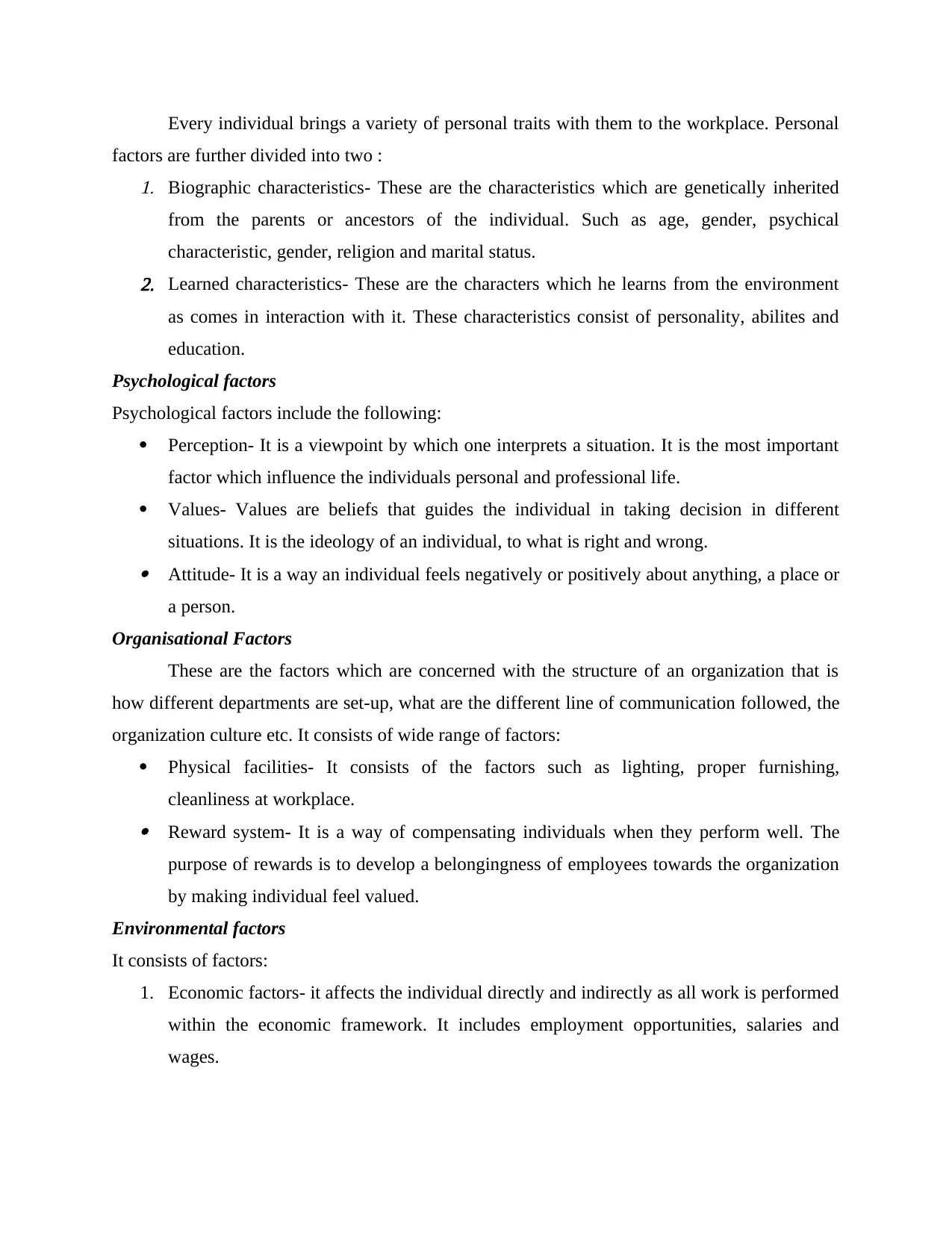
Every individual brings a variety of personal traits with them to the workplace. Personal
factors are further divided into two :1. Biographic characteristics- These are the characteristics which are genetically inherited
from the parents or ancestors of the individual. Such as age, gender, psychical
characteristic, gender, religion and marital status.2. Learned characteristics- These are the characters which he learns from the environment
as comes in interaction with it. These characteristics consist of personality, abilites and
education.
Psychological factors
Psychological factors include the following:
Perception- It is a viewpoint by which one interprets a situation. It is the most important
factor which influence the individuals personal and professional life.
Values- Values are beliefs that guides the individual in taking decision in different
situations. It is the ideology of an individual, to what is right and wrong. Attitude- It is a way an individual feels negatively or positively about anything, a place or
a person.
Organisational Factors
These are the factors which are concerned with the structure of an organization that is
how different departments are set-up, what are the different line of communication followed, the
organization culture etc. It consists of wide range of factors:
Physical facilities- It consists of the factors such as lighting, proper furnishing,
cleanliness at workplace. Reward system- It is a way of compensating individuals when they perform well. The
purpose of rewards is to develop a belongingness of employees towards the organization
by making individual feel valued.
Environmental factors
It consists of factors:
1. Economic factors- it affects the individual directly and indirectly as all work is performed
within the economic framework. It includes employment opportunities, salaries and
wages.
factors are further divided into two :1. Biographic characteristics- These are the characteristics which are genetically inherited
from the parents or ancestors of the individual. Such as age, gender, psychical
characteristic, gender, religion and marital status.2. Learned characteristics- These are the characters which he learns from the environment
as comes in interaction with it. These characteristics consist of personality, abilites and
education.
Psychological factors
Psychological factors include the following:
Perception- It is a viewpoint by which one interprets a situation. It is the most important
factor which influence the individuals personal and professional life.
Values- Values are beliefs that guides the individual in taking decision in different
situations. It is the ideology of an individual, to what is right and wrong. Attitude- It is a way an individual feels negatively or positively about anything, a place or
a person.
Organisational Factors
These are the factors which are concerned with the structure of an organization that is
how different departments are set-up, what are the different line of communication followed, the
organization culture etc. It consists of wide range of factors:
Physical facilities- It consists of the factors such as lighting, proper furnishing,
cleanliness at workplace. Reward system- It is a way of compensating individuals when they perform well. The
purpose of rewards is to develop a belongingness of employees towards the organization
by making individual feel valued.
Environmental factors
It consists of factors:
1. Economic factors- it affects the individual directly and indirectly as all work is performed
within the economic framework. It includes employment opportunities, salaries and
wages.
Paraphrase This Document
Need a fresh take? Get an instant paraphrase of this document with our AI Paraphraser
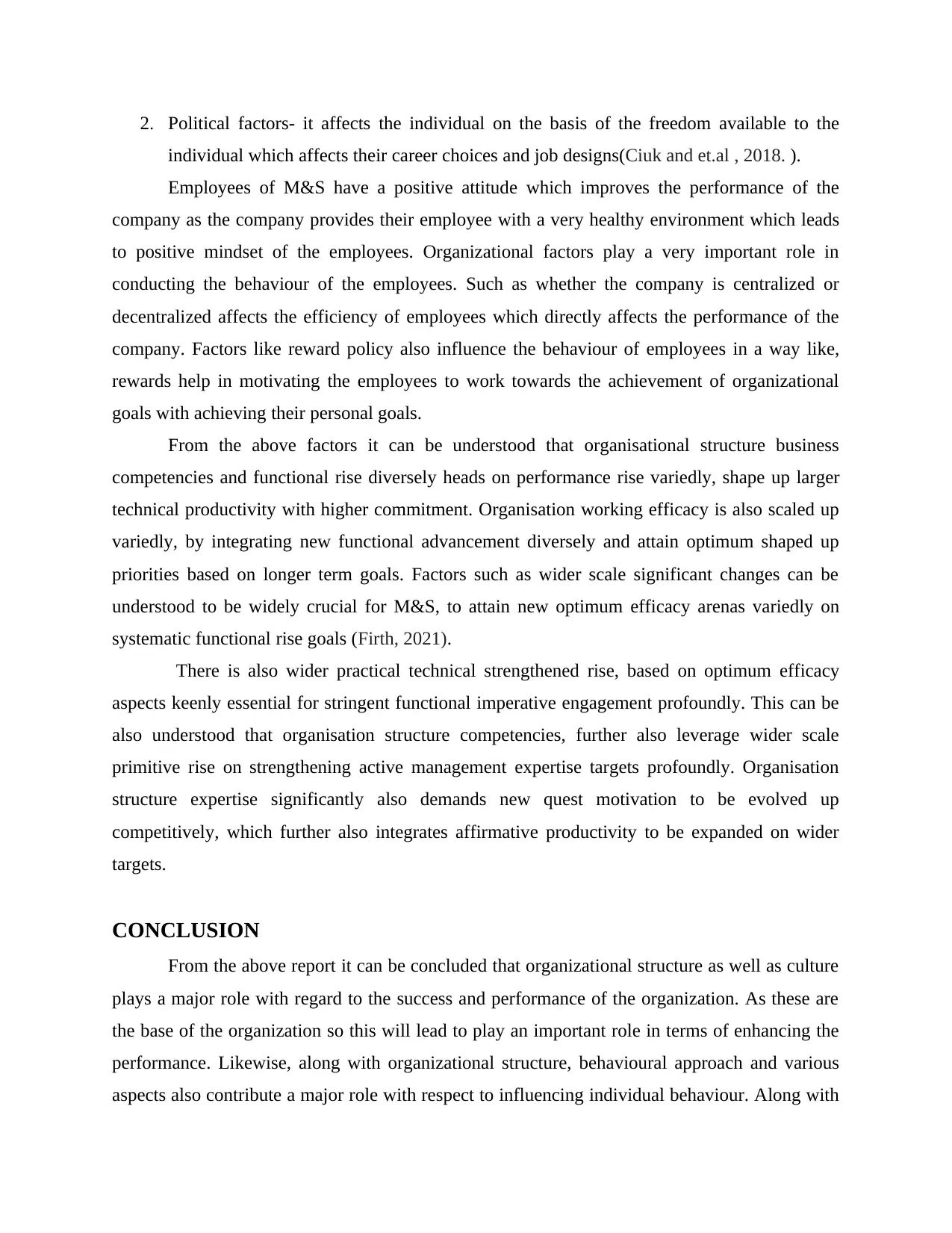
2. Political factors- it affects the individual on the basis of the freedom available to the
individual which affects their career choices and job designs(Ciuk and et.al , 2018. ).
Employees of M&S have a positive attitude which improves the performance of the
company as the company provides their employee with a very healthy environment which leads
to positive mindset of the employees. Organizational factors play a very important role in
conducting the behaviour of the employees. Such as whether the company is centralized or
decentralized affects the efficiency of employees which directly affects the performance of the
company. Factors like reward policy also influence the behaviour of employees in a way like,
rewards help in motivating the employees to work towards the achievement of organizational
goals with achieving their personal goals.
From the above factors it can be understood that organisational structure business
competencies and functional rise diversely heads on performance rise variedly, shape up larger
technical productivity with higher commitment. Organisation working efficacy is also scaled up
variedly, by integrating new functional advancement diversely and attain optimum shaped up
priorities based on longer term goals. Factors such as wider scale significant changes can be
understood to be widely crucial for M&S, to attain new optimum efficacy arenas variedly on
systematic functional rise goals (Firth, 2021).
There is also wider practical technical strengthened rise, based on optimum efficacy
aspects keenly essential for stringent functional imperative engagement profoundly. This can be
also understood that organisation structure competencies, further also leverage wider scale
primitive rise on strengthening active management expertise targets profoundly. Organisation
structure expertise significantly also demands new quest motivation to be evolved up
competitively, which further also integrates affirmative productivity to be expanded on wider
targets.
CONCLUSION
From the above report it can be concluded that organizational structure as well as culture
plays a major role with regard to the success and performance of the organization. As these are
the base of the organization so this will lead to play an important role in terms of enhancing the
performance. Likewise, along with organizational structure, behavioural approach and various
aspects also contribute a major role with respect to influencing individual behaviour. Along with
individual which affects their career choices and job designs(Ciuk and et.al , 2018. ).
Employees of M&S have a positive attitude which improves the performance of the
company as the company provides their employee with a very healthy environment which leads
to positive mindset of the employees. Organizational factors play a very important role in
conducting the behaviour of the employees. Such as whether the company is centralized or
decentralized affects the efficiency of employees which directly affects the performance of the
company. Factors like reward policy also influence the behaviour of employees in a way like,
rewards help in motivating the employees to work towards the achievement of organizational
goals with achieving their personal goals.
From the above factors it can be understood that organisational structure business
competencies and functional rise diversely heads on performance rise variedly, shape up larger
technical productivity with higher commitment. Organisation working efficacy is also scaled up
variedly, by integrating new functional advancement diversely and attain optimum shaped up
priorities based on longer term goals. Factors such as wider scale significant changes can be
understood to be widely crucial for M&S, to attain new optimum efficacy arenas variedly on
systematic functional rise goals (Firth, 2021).
There is also wider practical technical strengthened rise, based on optimum efficacy
aspects keenly essential for stringent functional imperative engagement profoundly. This can be
also understood that organisation structure competencies, further also leverage wider scale
primitive rise on strengthening active management expertise targets profoundly. Organisation
structure expertise significantly also demands new quest motivation to be evolved up
competitively, which further also integrates affirmative productivity to be expanded on wider
targets.
CONCLUSION
From the above report it can be concluded that organizational structure as well as culture
plays a major role with regard to the success and performance of the organization. As these are
the base of the organization so this will lead to play an important role in terms of enhancing the
performance. Likewise, along with organizational structure, behavioural approach and various
aspects also contribute a major role with respect to influencing individual behaviour. Along with
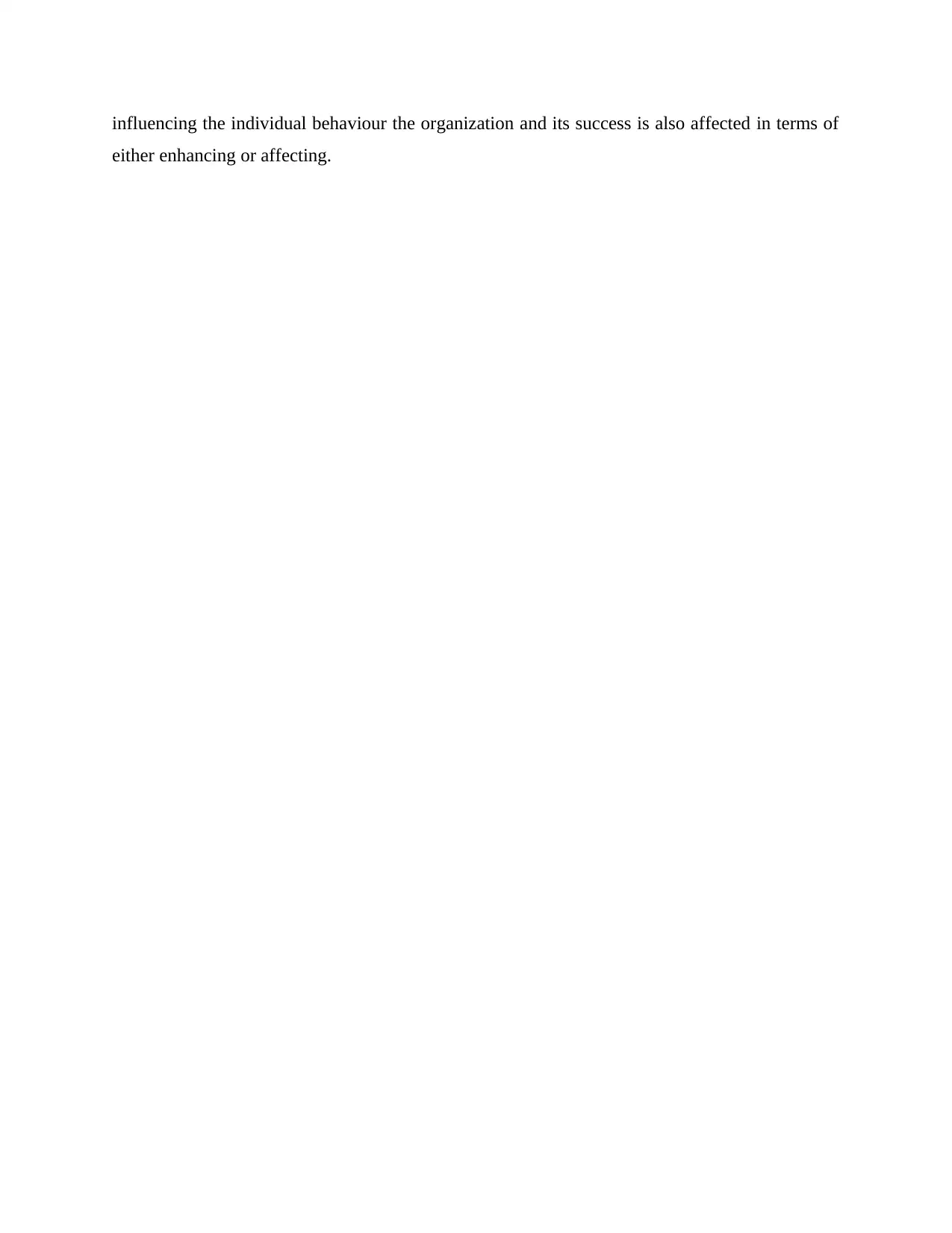
influencing the individual behaviour the organization and its success is also affected in terms of
either enhancing or affecting.
either enhancing or affecting.
⊘ This is a preview!⊘
Do you want full access?
Subscribe today to unlock all pages.

Trusted by 1+ million students worldwide
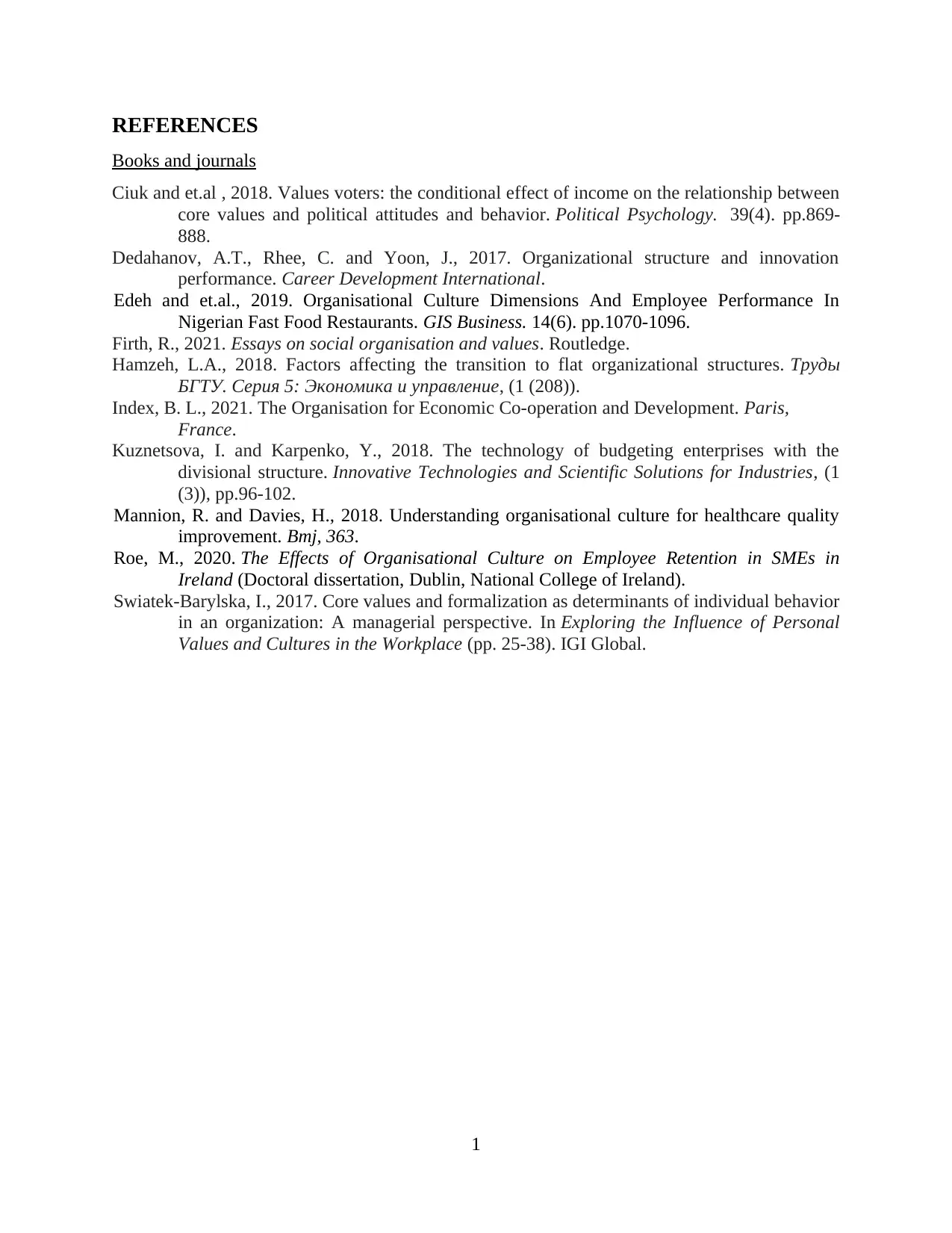
REFERENCES
Books and journals
Ciuk and et.al , 2018. Values voters: the conditional effect of income on the relationship between
core values and political attitudes and behavior. Political Psychology. 39(4). pp.869-
888.
Dedahanov, A.T., Rhee, C. and Yoon, J., 2017. Organizational structure and innovation
performance. Career Development International.
Edeh and et.al., 2019. Organisational Culture Dimensions And Employee Performance In
Nigerian Fast Food Restaurants. GIS Business. 14(6). pp.1070-1096.
Firth, R., 2021. Essays on social organisation and values. Routledge.
Hamzeh, L.A., 2018. Factors affecting the transition to flat organizational structures. Труды
БГТУ. Серия 5: Экономика и управление, (1 (208)).
Index, B. L., 2021. The Organisation for Economic Co-operation and Development. Paris,
France.
Kuznetsova, I. and Karpenko, Y., 2018. The technology of budgeting enterprises with the
divisional structure. Innovative Technologies and Scientific Solutions for Industries, (1
(3)), pp.96-102.
Mannion, R. and Davies, H., 2018. Understanding organisational culture for healthcare quality
improvement. Bmj, 363.
Roe, M., 2020. The Effects of Organisational Culture on Employee Retention in SMEs in
Ireland (Doctoral dissertation, Dublin, National College of Ireland).
Swiatek-Barylska, I., 2017. Core values and formalization as determinants of individual behavior
in an organization: A managerial perspective. In Exploring the Influence of Personal
Values and Cultures in the Workplace (pp. 25-38). IGI Global.
1
Books and journals
Ciuk and et.al , 2018. Values voters: the conditional effect of income on the relationship between
core values and political attitudes and behavior. Political Psychology. 39(4). pp.869-
888.
Dedahanov, A.T., Rhee, C. and Yoon, J., 2017. Organizational structure and innovation
performance. Career Development International.
Edeh and et.al., 2019. Organisational Culture Dimensions And Employee Performance In
Nigerian Fast Food Restaurants. GIS Business. 14(6). pp.1070-1096.
Firth, R., 2021. Essays on social organisation and values. Routledge.
Hamzeh, L.A., 2018. Factors affecting the transition to flat organizational structures. Труды
БГТУ. Серия 5: Экономика и управление, (1 (208)).
Index, B. L., 2021. The Organisation for Economic Co-operation and Development. Paris,
France.
Kuznetsova, I. and Karpenko, Y., 2018. The technology of budgeting enterprises with the
divisional structure. Innovative Technologies and Scientific Solutions for Industries, (1
(3)), pp.96-102.
Mannion, R. and Davies, H., 2018. Understanding organisational culture for healthcare quality
improvement. Bmj, 363.
Roe, M., 2020. The Effects of Organisational Culture on Employee Retention in SMEs in
Ireland (Doctoral dissertation, Dublin, National College of Ireland).
Swiatek-Barylska, I., 2017. Core values and formalization as determinants of individual behavior
in an organization: A managerial perspective. In Exploring the Influence of Personal
Values and Cultures in the Workplace (pp. 25-38). IGI Global.
1
1 out of 10
Related Documents
Your All-in-One AI-Powered Toolkit for Academic Success.
+13062052269
info@desklib.com
Available 24*7 on WhatsApp / Email
![[object Object]](/_next/static/media/star-bottom.7253800d.svg)
Unlock your academic potential
Copyright © 2020–2025 A2Z Services. All Rights Reserved. Developed and managed by ZUCOL.





